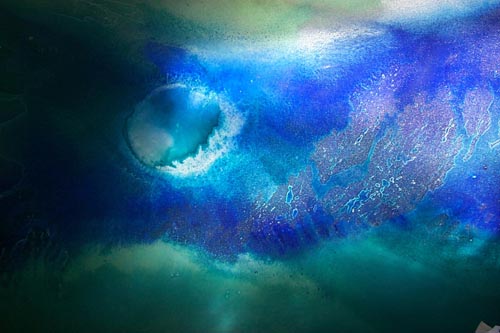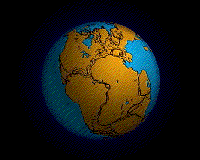
Original acrylic on canvas painting by Betsy Heilman
P A N G A E A
The Continent

Original acrylic on canvas painting by Betsy Heilman
Some 300 million years ago all the world's land masses were beginning to form into one supercontinent, Pangaea, surrounded by a single universal sea, Panthalassa. Through the upheavals that we have since come to know as plate tectonics, the shifting of the Earth's crust tore the supercontinent asunder about the middle of the Mesozoic period (approximately 180 million years B.P.) and large bodies of land drifted across the surface of the Earth to ultimately become our present-day continents.
The theory of continental drift was first proposed by German meteorologist Alfred Wegener in 1912. It was not until the 1960s, however, when geologist Harry H. Hess and oceanographer Robert S. Dietz developed the theory of seafloor spreading that Wegener's postulate gained acceptance. Taken together, they led to the theory of plate tectonics, or global tectonics. The name of the supercontinent "was coined during a 1927 symposium discussing Alfred Wegener's theory of continental drift," according to Wikipedia.
It is now believed that the several moving plates of the Earth's crust are formed by volcanic activity at the oceanic ridges and destroyed in great seafloor trenches at the margins of the continents, accounting for the massive redefinition of the Earth's surface over millenia.
Certain species of terrestrial mammals became isolated, as a result, in Antarctica, South America, Africa, and Australia. It would be thousands of years before volcanic eruption would reunite South America with the North American continent again in a land bridge.

Animation of the rifting
of Pangaea (Wikipedia)
This website has been selected by the National Science Teachers Association (NSTA)
for its science links (SciLinks) program to augment textbook learning.
